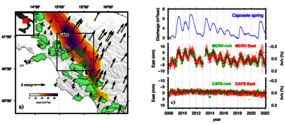Probing the elastic properties of the crust with hydrological deformation transients
Natural oscillatory stress sources (tides, seasonal and multiannual) can be exploited to probe the response of active fault zones to stress variations at various temporal and spatial scales and investigate time-dependent variations of their mechanical properties. We carried out a multidisciplinary (seismology, geodesy) study to investigate the response of the Irpinia Fault System (IFS, Southern Apennines, Italy) to hydrological forcing associated with recharge/discharge phases of karst aquifers and its time-dependent elastic and hydraulic properties. Charge/discharge phases of the karst aquifers in the Apennines cause significant seasonal and multi-annual strain transients (Silverii et al, 2019), that modulate the secular, tectonic deformation (~3 mm/yr extension across the Apennines). Recent studies (Silverii et al., 2016; D’Agostino et al., 2018) have shown the high sensitivity of the IFS to hydrological stresses reflected in its time-dependent deformation and seismicity response. Pump-probe experiments investigate the strain sensitivity of crustal elastic properties, showing nonlinear variations during the strain cycle. In the laboratory, pre-seismic reductions in seismic velocity indicate that the pattern of asperity contacts within the fault zone changes before the macroscopic frictional sliding. The recognition of such effects in natural seismic-cycles has been challenging. Here we exploit seasonal hydrological strains, performing a natural analogue to a quasi-static laboratory pump-probe experiment to investigate the nonlinear strain sensitivity of crustal rocks and its role in seismic failure along the IFS. While seasonal horizontal hydrological strains are used as the “pump”, coda wave interferometry demonstrates to be a powerful tool to probe time-dependent crustal elastic properties. We computed seismic velocity variations dv/v using empirical Green's functions reconstructed by autocorrelation on continuous time series of ambient seismic noise. By comparing 14-years-long series of spring discharge, strain, seismic velocity variations and earthquakes rate, we find that seismicity peaks during maximum hydrological forcing and minimum seismic velocity. Seasonal strains of ~10−6 are required for both earthquake triggering and significant nonlinearity effects arising from modulus reduction. We suggest that, for faults in a critical state, cyclical softening may lead to failure and seasonal seismicity.

